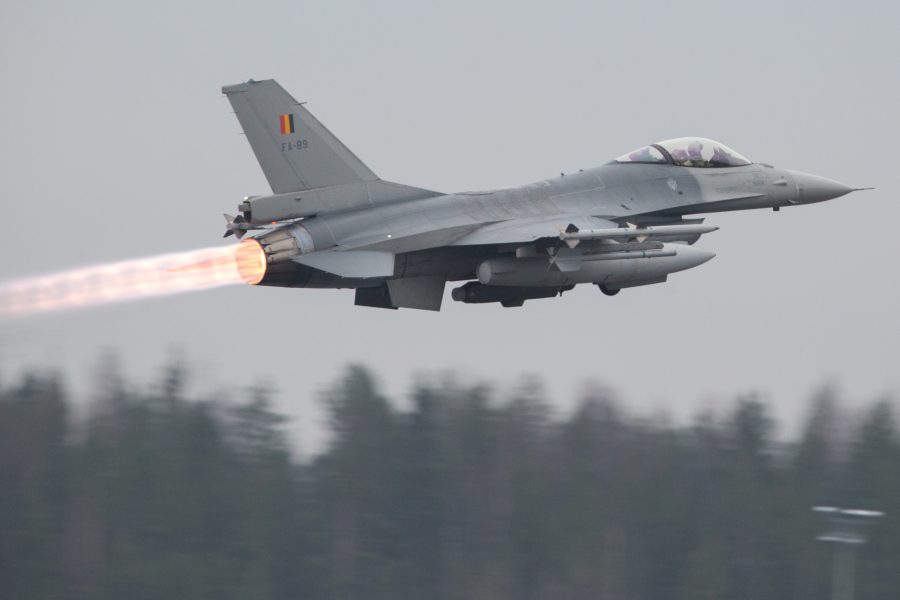Belgium pledged to provide Ukraine with more than two dozen F-16s in a pact agreed to by Ukrainian President Volodymyr Zelenskyy and Belgian Prime Minister Alexander De Croo during the Ukrainian leader’s visit to the country May 28.
The F-16s will be delivered “as quickly as possible,” according to the security cooperation agreement. But Belgium’s pledge comes with significant caveats.
The agreement does not guarantee that the first Belgian F-16s will arrive before the end of 2024, though it says the Belgian government will strive to meet the end-of-year goal. That’s because the F-16 delivery schedule is linked to Belgium’s acquisition of F-35As to maintain and strengthen its own military capabilities.
“Belgium will do everything possible, in consultation with its allies and partners of the F-16 coalition, to accelerate the first delivery, if possible before the end of 2024, without endangering its security and the operationally of its air capacity and taking into account the delivery of the F-35s to the Belgian Air Component and subsequent decommissioning of the F-16s,” the agreement states.
Ukraine also cannot use Belgian-provided F-16s over Russian territory, according to the pact.
“Everything which is covered by this agreement is very clear—it is for utilization by the Ukraine Defense Forces on Ukraine[‘s] territory,” De Croo said.
Belgium has already received its first F-35, and the first training on the jets by the country’s Air Component, as its air force is known, is scheduled for this summer. Belgium’s government has previously announced its intent to buy 34 F-35s to replace its F-16 fleet. Belgium plans to give Ukraine 30 F-16s by 2028.
“F-16 jets will be provided to Ukraine as soon as possible,” De Croo said. “Our aim is to be able to provide the first aircraft before the end of this year, 2024.”
Lockheed Martin’s deliveries of F-35s have generally been hampered by delays in software and hardware issues associated with the Technology Refresh 3 and Block 4 upgrades
“Ukraine is looking forward to receiving F-16 fighter jets from its Western partners to strengthen the defense of our skies,” Zelenskyy said in a statement on social media.
Norway, Denmark, and the Netherlands have also pledged to provide the U.S.-made fighters.
Zelenskyy visited Melsbroek Air Base in Belgium, where he met with Ukrainian service members who are being trained to maintain F-16. “We are also waiting for our warriors, who are training to maintain F-16s, at home,” Zelenskyy said in his statement. “They are highly motivated to start performing combat missions and speed up the victory of our country.”
The Belgium-Ukraine agreement says the F-16s will be used to “strengthen Ukraine’s defense capacity and defend its airspace and territory against Russian military targets.” But it does not spell out what munitions will be provided or specify details on how the F-16 will be maintained and where the aircraft will be based.
The agreement says that Belgium is working on how to provide “F-16 ordnance” and will be part of a coalition that helps train Ukrainian pilots and technicians, supports the long-term maintenance of the fighters, and establishes “proper facilities in Ukraine.”
The first American-trained Ukrainian F-16 pilots have graduated from U.S.-based training at the 162nd Wing of the Arizona Air National Guard, Air & Space Forces Magazine reported May 23.
Ukraine has already employed air-launched Western munitions, but they have proved to be less effective than hoped, according to a recent report by The Washington Post, due to Russian electronic warfare, especially JDAM-guided bombs. Some weapons reportedly used by Ukraine, such as air-launched small-diameter bombs, have proved more resilient to jamming, according to the Post, which cited confidential Ukrainian assessments.
U.S. officials have previously noted that Ukrainian pilots have had to fly low to avoid Russian air defenses, reducing the effectiveness of weapons. “They’re somewhat effective,” a U.S. senior defense official said in February of the Ukrainian Air Force. “The problem they have, that Russia has as well, is both sides have a pretty sophisticated integrated air and missile defense system.”


